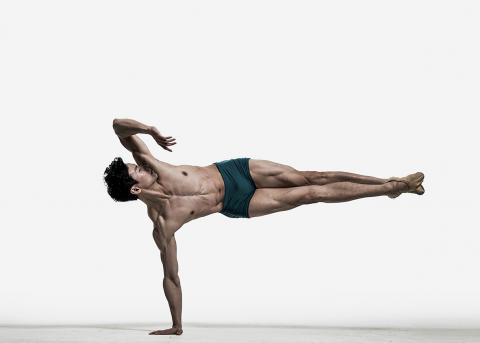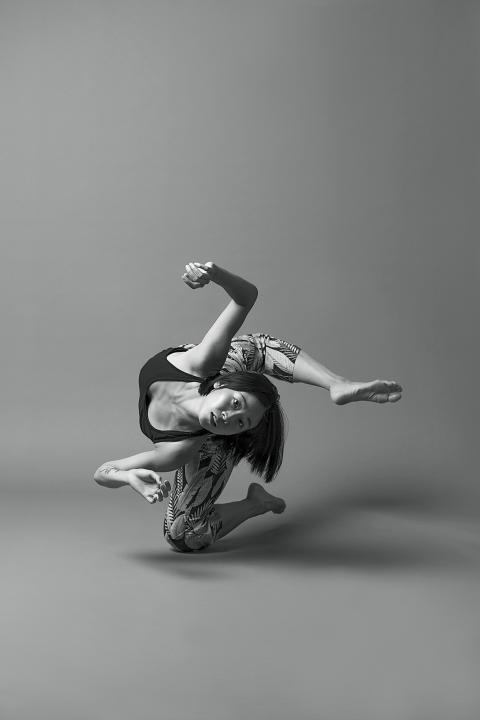Ho Hsiao-mei’s (何曉玫) Meimage Dance New Choreographer Project (鈕扣*New Choreographer計畫) has built an enviable reputation over the past eight years as a platform for Taiwanese dancers and choreographers working abroad to showcase their talent for home audiences, as well as a crucible for thought-provoking works.
For some past participates, the program has helped ease their transition home or led to their being offered more work here. Some of the dances have also been nominated for national awards.
This year’s edition of the New Choreographer Project, the ninth, looks to be as equally engaging. Ho invited four dancers — Connie Shiau (蕭潔恒), Ying Ting-an (鄞廷安), Liu Fang-yi (劉方怡) and Liang Shih-huai (梁世懷) — who are little known at home.

Photo courtesy of Meimage Dance
As has been the case with previous editions, most of the invitees have had some connection with the Taipei National University of the Arts (TNUA, 國立臺北藝術大學), where Ho is now dean of the School of Dance.
Tainan-born Shiau, a member of Hubbard Street Dance Chicago, is the exception: She attended Purchase College, State University of New York, but she was named as one of Dance Magazine’s 25 to Watch last year, joining the ranks of Taiwanese notables such as Sheu Fang-yi (許芳宜), named in 2005, Chen Peng-yu (陳芃羽) in 2007 and Huang Yi (黃翊) in 2010.
Ying, a freelancer who has been working with emanuel gat dance in France among other European troupes, and Liu, a member of the Leipzig Ballet, are both TNUA alumni, while Liang, a soloist with the Seoul-based Universal Ballet, started at the university’s seven-year high-school-to-bachelor’s degree program, but left to pursue ballet studies in the US.

Photo courtesy of Hubbard Street Dance Chicago
While Shiau and Liang have choreographed solos, Ying and Liu — who was also in last year’s New Choreographer Project — have brought two other dancers they met through their companies, Robert Bridger and Yan Leiva respectively,
Ying’s piece, Twoo, Liu’s Centurion and Liang’s Define focus on exploring the essence of life and of self, while Shiau was inspired by the #MeToo movement to explore contemporary women’s situations and gender issues for her piece, 108.
Given the four dancers’ busy schedules, Ho was not able to arrange a long residency period in Taipei for when they could all be together this summer, so they flew in and out of Taipei as their schedules allowed. That also made it difficult to do the usual news conferences and promotional interviews.

Photo courtesy of Meimage Dance
However, I was able to sit down with Liang while he was in town last month to find out more about his piece, and how a Taipei-born dancer became a leading member of a ballet company in South Korea.
Liang said he had always loved dancing, and his parents, who are both artists, had supported his interest even though they knew little about dance themselves.
However, it was not until his second year at TNUA high school that he realized how much he loved ballet and how much he wanted to make a career out in it. But his has not been an easy path, nor a straight-forward one.
“At 17, a friend and I decided to go to the Prix de Lausanne [an international competition for dancers aged 15 to 18 who are not yet professionals] — it was the only one we had heard of,” Liang said.
However, Lausanne was a shock, because it made him realize how far behind he was in terms of training compared to others his age, and how far he had to go if he wanted to dance professionally.
“We did not do well at all,” he laughed.
Liang also realized that he could not stay at TNUA since its two ballet classes per week were nowhere near enough for what he needed.
He had met ballet teacher and dance promoter Wang Tzer-shing (王澤馨) before going to Lausanne, and she had given him some coaching. Since she had studied and worked professionally in the US, he asked her for recommendations of colleges or dance schools he should apply to.
He ended up being accepted to the University of North Carolina School of the Arts and the Kirov Academy in Washington, and had decided to go to North Carolina because it would cost less.
“Then the school called and said they needed my TOFEL score, but my English was not very good at all and I knew I could not pass the test,” he said.
As a private institution, the Kirov would be a lot more expensive, but Liang said he pleaded with his mother and somehow she came up with the money, and so in 2004 he moved to Washington.
“I was the first Taiwanese at the school, and I had great teachers from Russia,” he said.
After finishing his studies at the Kirov, he joined a very small troupe in South Carolina, the Colombia Classical Ballet.
“It was not a great experience. There were only 15 dancers, we often bought our costumes from WalMart, and we had to go to local stores to hand out flyers for performances,” he said.
However, Liang said without his time in South Carolina, he probably would not be in a professional company today.
“I went through the wars there,” he said.
At a ballet competition in New York City, he met three couples from South Korea, two of whom danced with Universal Ballet.
“I didn’t do well, but one of the women introduced me to Julia Moon [Universal’s artistic director] when she came to see them dance, and a few weeks later I got an e-mail from the company,” he said.
Universal was going to stage Romeo and Juliet and wanted him in it, but deciding to move to South Korea was risky because the company said it could not tell him what kind of contract it could offer until he got to Seoul.
Plus, his dream had always been to work with the American Ballet Theater, ever since he saw the company perform Don Quixote in Taipei.
“It was a big struggle about coming back to Asia to do ballet, but I really did not have a lot of choices,” Liang said.
He stayed with Universal from 2007 to 2016, when he moved to the Royal New Zealand Ballet, but a change of directors in that company meant he only stayed in Wellington for one-and-a-half years.
He and his wife, a South Korean who was also a dancer with Universal, decided to return to Seoul and he rejoined Universal.
However, Liang is now 32 and he knows the clock is ticking on his dance career.
“When your age goes up, your technique goes down,” he said.
So the invitation to take part in this year’s New Choreographer Project was a chance to try his hand at choreographing as well also an opportunity to introduce himself to Taiwanese audiences.
“People here don’t know me,” he said, adding: “I have always love learning new stuff, but I didn’t know if I would love choreographing or hate it.”
Liang said it has been an interesting journey of discovery. At first he thought he would make a contemporary piece.
“But then I started thinking, ‘This is stupid. Why am I giving up what I know, why not do something that I have been polishing for years?’” he said.
Ballet is difficult because we are always trying to be perfect in someone else’s eyes, he said.
“Now I am finding my own language of my body. It is all about me,” he said.
For his solo, he choose two favorite pieces of classical music — Johann Sebastian Bach’s Goldberg Variations #1 and Claude Debussy’s Clair de lune, and he asked a dancer friend who is also a DJ to compose a more contemporary piece.
“It has a strong beat, he did a good job,” Liang said.
Asked if creating Define had made him want to continue choreographing, Liang laughed and said he was giving himself three chances.
“I don’t want to waste someone else’s time or make myself miserable, but so far I like it, and I will certainly try a second time,” he said.

This month the government ordered a one-year block of Xiaohongshu (小紅書) or Rednote, a Chinese social media platform with more than 3 million users in Taiwan. The government pointed to widespread fraud activity on the platform, along with cybersecurity failures. Officials said that they had reached out to the company and asked it to change. However, they received no response. The pro-China parties, the Chinese Nationalist Party (KMT) and Taiwan People’s Party (TPP), immediately swung into action, denouncing the ban as an attack on free speech. This “free speech” claim was then echoed by the People’s Republic of China (PRC),

Exceptions to the rule are sometimes revealing. For a brief few years, there was an emerging ideological split between the Democratic Progressive Party (DPP) and Chinese Nationalist Party (KMT) that appeared to be pushing the DPP in a direction that would be considered more liberal, and the KMT more conservative. In the previous column, “The KMT-DPP’s bureaucrat-led developmental state” (Dec. 11, page 12), we examined how Taiwan’s democratic system developed, and how both the two main parties largely accepted a similar consensus on how Taiwan should be run domestically and did not split along the left-right lines more familiar in

As I finally slid into the warm embrace of the hot, clifftop pool, it was a serene moment of reflection. The sound of the river reflected off the cave walls, the white of our camping lights reflected off the dark, shimmering surface of the water, and I reflected on how fortunate I was to be here. After all, the beautiful walk through narrow canyons that had brought us here had been inaccessible for five years — and will be again soon. The day had started at the Huisun Forest Area (惠蓀林場), at the end of Nantou County Route 80, north and east

Specialty sandwiches loaded with the contents of an entire charcuterie board, overflowing with sauces, creams and all manner of creative add-ons, is perhaps one of the biggest global food trends of this year. From London to New York, lines form down the block for mortadella, burrata, pistachio and more stuffed between slices of fresh sourdough, rye or focaccia. To try the trend in Taipei, Munchies Mafia is for sure the spot — could this be the best sandwich in town? Carlos from Spain and Sergio from Mexico opened this spot just seven months ago. The two met working in the